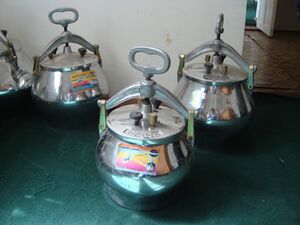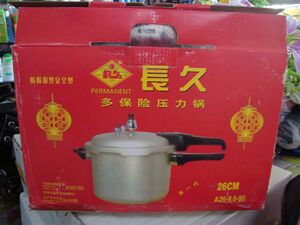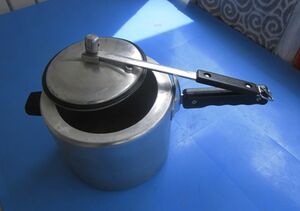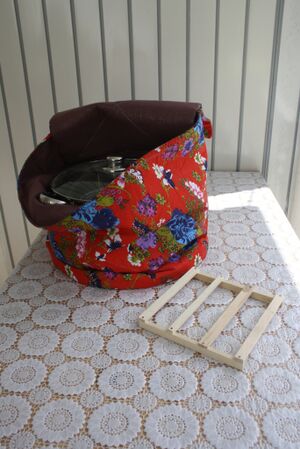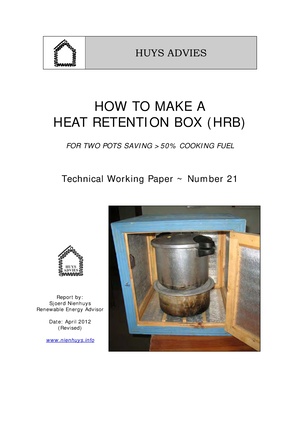Difference between revisions of "General Kitchen Management Practices"
***** (***** | *****) |
***** (***** | *****) |
||
| Line 5: | Line 5: | ||
This section deals with technologies and techniques that can save substantial amounts of energy, regardless of the type of fuel and stove used. <br>Fuel preparation and handling of the stove offer a high potential to improve efficiency and limit resource use for cooking. One option for users is to '''adjust their behaviour and adopt efficient cooking practices regardless of the type of stove and the fuel'''. <br>Another option is to integrate '''energy saving devices''' into the household cooking system like pressure cookers or heat retainers, like thermos flasks, heat retaining boxes also called hay box or hot bag. | This section deals with technologies and techniques that can save substantial amounts of energy, regardless of the type of fuel and stove used. <br>Fuel preparation and handling of the stove offer a high potential to improve efficiency and limit resource use for cooking. One option for users is to '''adjust their behaviour and adopt efficient cooking practices regardless of the type of stove and the fuel'''. <br>Another option is to integrate '''energy saving devices''' into the household cooking system like pressure cookers or heat retainers, like thermos flasks, heat retaining boxes also called hay box or hot bag. | ||
| − | = Fuel-saving cooking practices = | + | = Fuel-saving cooking practices = |
| − | Simple changes in the cooking practices of households can save substantial amounts of fuel. Like with any type of work: the overall-efficiency of a process depends to a great deal on how you plan it and manage each individual step. Although cooking is often done outdoors, these no-cost techniques are commonly called 'kitchen management practices'.<br | + | Simple changes in the cooking practices of households can save substantial amounts of fuel. Like with any type of work: the overall-efficiency of a process depends to a great deal on how you plan it and manage each individual step. Although cooking is often done outdoors, these no-cost techniques are commonly called 'kitchen management practices'.<br>Often the impact of simple behavioural changes is overlooked, or is not known to the project staff or partner organisations. Since most of these practices do not require additional tools or devices, households can save energy at little or no cost. Nevertheless, [[User Training - ICS|changes in cooking traditions and habits]] are usually not easy to achieve, and therefore convincing people can be a difficult task, especially within projects.<br>Regardless of the region and the stove and fuel used the following guidance can be applied everywhere to save energy while cooking:<br>'''Don't waste fuel by running an empty stove''' |
| − | *Get all the ingredients needed for the dish readily prepared (collecting, washing, cutting, etc.) before you start the fire. | + | *Get all the ingredients needed for the dish readily prepared (collecting, washing, cutting, etc.) before you start the fire. |
| − | *Have all ingredients and utensils at hand close to the stove, including cooking tools, water, and spices. | + | *Have all ingredients and utensils at hand close to the stove, including cooking tools, water, and spices. |
| − | *Don't waste time once the fire is started and avoid wandering off (e.g. to chat with your neighbour) while the stove is already on. | + | *Don't waste time once the fire is started and avoid wandering off (e.g. to chat with your neighbour) while the stove is already on. |
*Extinguish the fire when you have finished cooking. | *Extinguish the fire when you have finished cooking. | ||
| − | '''Make the best use of the heat from the fire''' | + | '''Make the best use of the heat from the fire''' |
| − | *Ensure that the heat generated from the fire finds its way into the pot. | + | *Ensure that the heat generated from the fire finds its way into the pot. |
| − | *If possible use a metal pot that conducts heat better than a clay pot. | + | *If possible use a metal pot that conducts heat better than a clay pot. |
| − | *If possible use a pot with a flat bottom instead of round-shaped pots. The transfer of heat into a flat-bottom pot is higher. | + | *If possible use a pot with a flat bottom instead of round-shaped pots. The transfer of heat into a flat-bottom pot is higher. |
| − | *Shield the pot from wind e.g. with a skirt around the pot, otherwise the hot flue gases will be blown away and the pot will be cooled by the wind. | + | *Shield the pot from wind e.g. with a skirt around the pot, otherwise the hot flue gases will be blown away and the pot will be cooled by the wind. |
| − | *Reduce the intensity of the fire once the food has come to a boil. | + | *Reduce the intensity of the fire once the food has come to a boil. |
| − | *Use a heat retaining devise after [[General Kitchen Management Practices#Keep_cool.2C_stay_hot_-_cooking_with_retained_heat|boiling]]. | + | *Use a heat retaining devise after [[General Kitchen Management Practices#Keep_cool.2C_stay_hot_-_cooking_with_retained_heat|boiling]]. |
| − | *Use always a lid on the pot to prevent surplus steam escaping from the pot (steam is water heated beyond boiling point, so any steam leaving the pot is energy lost for the cooking process). | + | *Use always a lid on the pot to prevent surplus steam escaping from the pot (steam is water heated beyond boiling point, so any steam leaving the pot is energy lost for the cooking process). |
*Use small amounts of water for cooking: any water that is thrown away after cooking has consumed a lot of energy until it boiled. This practice not only saves fuel but also retains nutrients. | *Use small amounts of water for cooking: any water that is thrown away after cooking has consumed a lot of energy until it boiled. This practice not only saves fuel but also retains nutrients. | ||
| − | |||
| − | *Soak dried food (such as beans, peas, rice, etc.) prior to cooking. | + | |
| − | *Cut food up into smaller pieces: e.g. cut smaller cubes or slices instead of boiling a whole potato or cassava root. | + | '''Shorten cooking times of certain foods''' |
| + | |||
| + | *Soak dried food (such as beans, peas, rice, etc.) prior to cooking. | ||
| + | *Cut food up into smaller pieces: e.g. cut smaller cubes or slices instead of boiling a whole potato or cassava root. | ||
*Don't overcook food. Monitor the cooking process closely by testing regularly if the food is already cooked. Once the food is ready to eat, take it off the stove. | *Don't overcook food. Monitor the cooking process closely by testing regularly if the food is already cooked. Once the food is ready to eat, take it off the stove. | ||
| − | Efficient cooking practices do not only take place in the kitchen itself, but already start with fuel management. Therefore please read as well the chapter’s [[Cooking with firewood|firewood management]] and [[Cooking with other Biomass Fuels (dung, residues, alcohol, gas)|other solid biomass fuels]]. | + | Efficient cooking practices do not only take place in the kitchen itself, but already start with fuel management. Therefore please read as well the chapter’s [[Cooking with firewood|firewood management]] and [[Cooking with other Biomass Fuels (dung, residues, alcohol, gas)|other solid biomass fuels]]. |
| − | == Additional information<br | + | == Additional information<br> == |
| − | {| | + | {| cellspacing="1" cellpadding="1" width="100%" border="1" |
|- | |- | ||
| − | | <br | + | | <br>Efficient cooking practices based on experience from Malawi in English and French<br><br><br> |
| | | | ||
| − | *[[:file:GTZ 3a FS kitchen management 2010.pdf|No cost techniques kitchen management practices]] | + | *[[:file:GTZ 3a FS kitchen management 2010.pdf|No cost techniques kitchen management practices]] |
| − | *[[ | + | *[[Image:GIZ HERA l’utilisation du bois 2011.pdf|Les techniques sans coût pour la gestion de la cuisine]] |
| − | |||
| + | <br> | ||
|- | |- | ||
| − | | Efficient cooking practices based on experience from Burkina Faso in French<br | + | | Efficient cooking practices based on experience from Burkina Faso in French<br> |
| | | | ||
| − | *T<span style="color: rgb(255, 0, 0)">echniques efficaces de la cuisine</span> | + | *T<span style="color: rgb(255,0,0)">echniques efficaces de la cuisine</span> |
|- | |- | ||
| − | | <br | + | | <br> |
| − | | <br | + | | <br> |
|- | |- | ||
| − | | <br | + | | <br> |
| − | | <br | + | | <br> |
|} | |} | ||
Revision as of 09:59, 4 January 2012
--> Back to Overview GIZ HERA Cooking Energy Compendium
General kitchen management practices
This section deals with technologies and techniques that can save substantial amounts of energy, regardless of the type of fuel and stove used.
Fuel preparation and handling of the stove offer a high potential to improve efficiency and limit resource use for cooking. One option for users is to adjust their behaviour and adopt efficient cooking practices regardless of the type of stove and the fuel.
Another option is to integrate energy saving devices into the household cooking system like pressure cookers or heat retainers, like thermos flasks, heat retaining boxes also called hay box or hot bag.
Fuel-saving cooking practices
Simple changes in the cooking practices of households can save substantial amounts of fuel. Like with any type of work: the overall-efficiency of a process depends to a great deal on how you plan it and manage each individual step. Although cooking is often done outdoors, these no-cost techniques are commonly called 'kitchen management practices'.
Often the impact of simple behavioural changes is overlooked, or is not known to the project staff or partner organisations. Since most of these practices do not require additional tools or devices, households can save energy at little or no cost. Nevertheless, changes in cooking traditions and habits are usually not easy to achieve, and therefore convincing people can be a difficult task, especially within projects.
Regardless of the region and the stove and fuel used the following guidance can be applied everywhere to save energy while cooking:
Don't waste fuel by running an empty stove
- Get all the ingredients needed for the dish readily prepared (collecting, washing, cutting, etc.) before you start the fire.
- Have all ingredients and utensils at hand close to the stove, including cooking tools, water, and spices.
- Don't waste time once the fire is started and avoid wandering off (e.g. to chat with your neighbour) while the stove is already on.
- Extinguish the fire when you have finished cooking.
Make the best use of the heat from the fire
- Ensure that the heat generated from the fire finds its way into the pot.
- If possible use a metal pot that conducts heat better than a clay pot.
- If possible use a pot with a flat bottom instead of round-shaped pots. The transfer of heat into a flat-bottom pot is higher.
- Shield the pot from wind e.g. with a skirt around the pot, otherwise the hot flue gases will be blown away and the pot will be cooled by the wind.
- Reduce the intensity of the fire once the food has come to a boil.
- Use a heat retaining devise after boiling.
- Use always a lid on the pot to prevent surplus steam escaping from the pot (steam is water heated beyond boiling point, so any steam leaving the pot is energy lost for the cooking process).
- Use small amounts of water for cooking: any water that is thrown away after cooking has consumed a lot of energy until it boiled. This practice not only saves fuel but also retains nutrients.
Shorten cooking times of certain foods
- Soak dried food (such as beans, peas, rice, etc.) prior to cooking.
- Cut food up into smaller pieces: e.g. cut smaller cubes or slices instead of boiling a whole potato or cassava root.
- Don't overcook food. Monitor the cooking process closely by testing regularly if the food is already cooked. Once the food is ready to eat, take it off the stove.
Efficient cooking practices do not only take place in the kitchen itself, but already start with fuel management. Therefore please read as well the chapter’s firewood management and other solid biomass fuels.
Additional information
Efficient cooking practices based on experience from Malawi in English and French |
|
| Efficient cooking practices based on experience from Burkina Faso in French |
|
Pressure Cookers
Pressure cookers are special cooking pots that can be sealed airtight and allow pressure to build up inside. With a mechanical device (screws or interlocking parts) the pot-lid can be pressed firmly against the pot-body. A gasket or seal in between the lid and the pot prevents steam to escape from the pot. With rising heat, the steam pressure inside the pot builds up beyond atmospheric pressure, allowing the temperatures to rise well above boiling point. To prevent explosions, regulators and safety valves let surplus pressure escape.
So far, pressure cookers have often been overlooked as potential components of efficient integrated cooking systems. If seals can be replaced, the life span of a pressure cooker usually by far exceeds the lifespan of a stove. Decision makers and project implementers might want to consider options to facilitate access to durable pressure cookers that can be used with any stove-type, as alternative or complementing measure to a new stove technology and/or a new fuel.
Worldwide different models of pressure cookers are offered on markets. In order to find the most appropriate model different features have to be taken into consideration, like price, size, main kind of stove applied (electric, gas, fire), quality aspects concerning durability, maintenance. The following pictures show examples of pressure cookers found during a market analysis in Tajikistan in 2010/2011.
| Afghan pressure cooker, without any plastic parts. (Picture: Heike Volkmer) |
Chinese model (Picture: Heike Volkmer) |
| Pressure cooker (Picture: Friederike Müller) |
Old Soviet pressure cooker (Picture: Friederike Müller) |
Significant advantages of using a pressure cooker are savings in time and energy because of:
- Higher temperatures above 100 °C reduce the time needed to cook the food. The temperature inside a pressure cooker can well go beyond 110° C.
- Very little steam can escape between the pot and the lid, thus less water is needed to cook the food.
Pressure cookers can be used with nearly any stove and fuel type. To use it on an open wood-fire, care should be taken that non-metal parts do not get exposed to the flames; otherwise they will melt or burn.
When a pressure cooker is used in combination with a fireless cooker, for some foods fuel savings can exceed 90%, e g. with some types of legumes, which need 4-5 hours to cook. If the pot is put into a heat retention bag or box before the pressure valve releases steam, no energy in form of steam is lost. Depending on the altitude, food to be cooked, type of pressure cooker and heat retention bag the following information should be gained:
- Cooking time to boil
- Cooking time after boil is reached
- Time, pot is remaining in the heat retention bag until the respective food is cooked
Pressure cookers are normally made from thick aluminium or stainless steel, which makes them heavier and more expensive than conventional pots. They might also be difficult to produce in many developing countries. Prices are seldom below 20 US$, top-of-the range products easily exceed 200 US$. Because of their cost, they have not yet spread into many rural areas. Pressure cookers are currently popular in urban areas, where the fuel has to be paid for in cash, and where the local foods can easily be cooked with pressure cookers: especially in Asia (China and India). To a much lesser extent pressure cookers are used in Latin America and South Africa.
In higher altitudes the low atmospheric pressure reduces the boiling point of water. Therefore the cooking is slower and requires more fuel or food remains undercooked. The required boiling time for softening the food is between one fourth and one fifth of the normal boiling time, depending on the altitude. As the steam within the pressure cooker creates a higher boiling temperature, the potential of pressure cookers to save fuel and cooking time rises with increasing altitudes, as shown in the following table:
| Altitude in meters | Sea level | 1000 m | 1500 m | 2250 m | 3000 m | Pressure cooker A |
| Boiling temp. degrees Celsius | 100 ºC | 96.6 ºC |
95 ºC | 92.2 ºC |
90 ºC |
118 ºC ~ 120 ºC |
(HEDON, issue 57 – 2009, Sjoerd Nienhuys, http://www.hedon.info/BP57_PressureCookerTraining?bl=y)
Advantages of pressure cookers
- Pressure cookers can be used with most fuel types and stoves.
- At high altitudes where the boiling point is naturally lower, they offer great advantages to raise the temperature above 100°C and prevent food to be left undercooked.
- Cooking is much faster and thus the pressure cooker can save considerable amounts of time and energy.
- It is possible to sterilise goods using a pressure cooker.
Disadvantages of pressure cookers
- Pressure cookers are more expensive than normal pots.
- Pressure cookers are used for steaming. As steam builds up inside, they cannot be used for frying or roasting.
- Pressure cookers can also not be used for foods that need to be stirred during cooking (like maize porridge).
- Opening the cooker must be done carefully since hot steam, under pressure, can escape with force and scald the cook.
- Pressure cookers are not appropriate for dishes, where different ingredients need to be added at different times, as they cannot easily be opened during cooking.
- Seal between the pot and the lid wears out and must be replaced; thus a service system has to be in place.
- Cooking with a pressure cooker requires the change of accustomed cooking processes (behaviour change).
- Due to the hotter steam the risk of scalding is higher.
Safety aspects
Appropriately used and maintained, pressure cookers are safe to use. It is really important that the safety valve and regulator are fully functional. Therefore pressure cookers should never be filled until the top of the pot, as the regulator and the valve can get blocked easily. In case of too high pressure the steam can abruptly escape, which can lead to scalding. Only if the pressure cooker is poorly maintained and inappropriate used the cooker can explode, which can result in serious injuries even if the pressure in the pot is relatively low.
Pressure cookers made from aluminium should not be cleaned with sharp items or with soda, as afterwards aluminium can enter the food, which will cause diseases. Pressure cookers should be operated only after reading the instruction manual.
Pressure cookers are as well applicable to cook traditional cooking recipes. But therefore new ways of cooking traditional dishes (user training and awareness training) have to be tested and disseminated, e.g. through a pressure cooker cookbook for traditional dishes. Yet, where they fit, they have a big potential to increase fuel efficiency from cooking.
Additional information:
| Experience based on a pressure cooker training in Tajikistan by Sjoerd Nienhuys in English | http://www.hedon.info/BP57_PressureCookerTraining?bl=y |
| Everything about pressure cookers: Pressure-Cooking Times & Instructions |
http://fastcooking.ca/pressure_cookers/cooking_times_pressure_cooker.php |
Keep cool, stay hot - cooking with retained heat
Retaining heat is a good way to delink the time of food preparation and the time of food consumption. This is especially helpful to complement a fuel that is not available on demand like solar energy. It allows having hot food even after sunset, when sunlight is not available to cook.
Heat retainers cannot substitute a stove, but they can be used to complement any stove and any fuel. In order to retain heat for cooking, heat needs to be generated first. By combining the heat retaining devices with other energy-efficient technologies (pressure cookers, solar stoves, ICS) or practices it can contribute to reduce the fuel consumption considerably.
Thermos flasks
Thermos flasks are an inexpensive way to maintain the heat of water, beverages or liquid foods like soup and porridge over time. In places, where food preparation is based on pouring hot water over food items like e.g. in Tibet, thermos flasks save fuel and enhance cooking comfort. Alongside solar cookers, families own up to five thermos flasks and store the water heated by the solar cooker during the day. The hot water is used for preparing both morning and evening meals (mainly soup and porridge) enabling the solar cooker to satisfy almost all household energy needs. However, this represents a rather specific case, which may not be transferable to many other countries. Yet, thermos flasks are currently underutilized and could probably play a more important role.
When promoting the use of thermos flasks, as well features concerning price, durability, cleaning, size and material (toxic) have to be considered.
Heat retention boxes or bags
The fuel consumption in the process of food preparation on a fire is not constant. A lot of fuel is required to heat up the content of a cooking pot to boil. Once it is boiling, it only takes little energy to keep it hot and maintain the temperature at boiling point. During the simmering of dishes with small energy input replaces the heat that is lost to the environment through the surface of the cooking pot and the closed lid. Some foods like legumes, (sweet) potatoes, meat, cassava or rice etc. do not require any stirring. The content of the pot has to be heated once to the boiling point and then kept at simmering level on a little flame without having to open the lid of the pot.
Instead of keeping the pot for a long time on a small fire, you can also wrap the cooking pot in an insulative cover which retains the heat in the pot. The food is cooking further as long as the temperature does not drop below 70°C. The simmering process of the food continues inside the wrapping. No further external heat supply or 'fire' is required. This is why this is called 'fireless cooking'. Based on the experience of the cook with cooking times of the specific foods, the food stays in the heat retainer until it is served.
Food can be kept warm for up to 6 hours, e.g. for people who return home late from the field or the market and want their children to find hot food when they come back home from school. Construction and functionality of the heat-retaining box (fireless cooker, hay box, hot bag etc.) depend on the insulative properties of the material used. The underlying principle of insulation is that air does not conduct heat. The more insulated pockets of air you can create between the cooking pot and the outside, the more heat will be retained inside the pot. Insulative materials are almost everywhere available. For example organic residues such as hay, sawdust, cotton waste, or dried leaves, e.g. from banana plants can be used. Other materials are waste paper, polystyrene beads, or vermiculite. An insulated lid or cushion closes the box or bag.
Depending on the type of food cooked and the traditional cooking practices, using heat retention bags can reduce fuelwood consumption to a great extent. Some people report that they can save up to 80% of their fuel, depending on the food and the efficiency of the insulation. An added benefit is that slow cooking retains many more of the food’s nutrients and vitamins than if prepared on a constantly hot fire. http://www.sunseedtanzania.org/home.php
|
|
Photo: C. Roth/GIZ |
Depending on the project frame it has to be decided, whether an approach for self constructing a heat retention bag or box at household level or a commercial approach for selling them is supported. This decision depends on the favoured dissemination approach of the project as well as on the available materials and costs for the heat retention box and bag. Below examples of different construction manuals are shown.
Advantages:
- Food can be kept warm for more than 24 hours.
- Fuel savings.
- Food cannot burn.
- Women spend less time cooking and are less exposed to smoke.
- Food can be left unattended in the hot bag, leaving women more time for other activities.
- Women can reduce the frequency of cooking by preparing enough food for two meals and putting half of it in the hay box to keep warm.
- Depending on the material used, heat retainers can be as well used for cooling.
- Heat retention bags and boxes can be made with almost no costs or purchased for little money.
Disadvantages:
- The technology is not applicable to all types of food; it is limited to dishes that are cooked slowly in liquid (beans, rice, meat etc.).
- If you open the lid of the pot and stir the content, the temperature goes down quickly and might go below the point where the food still cooks.
- Change of taste: if beans are prepared in a fireless cooker, they don't acquire the smoky taste as if they were cooked on a fire for long hours. They might be healthier, but they taste different and are sometimes rejected for that reason.
- It is not advisable to keep the food warm longer than six hours. Otherwise it might promote the growth of microorganisms in the food which puts the health at risk.
- In case the pot is used on open fire, people might refuse to put the black pot into the box or bag, in order not to soil it
- Cooking with a heat retention bag or box requires changing accustomed cooking processes. In order to show people the advantages of the heat retention box or bag cooking demonstrations, cooking books, etc. might be required.
For the decision on whether to choose a heat retention box or a bag the following points can be taken into consideration:
| Heat retention box |
Heat retention bag |
|---|---|
| An appropriate box in respective quality, quantity (availability) and price. | Material easily available and cheap |
Easier to keep clean |
Difficult to wash or clean surface material |
| Not adaptable to different pot sizes | Adoptable to different pot sizes |
| Higher transport costs |
Less space required for transportation, lower transportation costs |
| Higher production costs (material, labor) |
Lower production costs (material, labour) |
| Source for income generation | Source for income generation |
| Cooled items can be stored cool in the box. | When reflective foil is used, the reversed bag can be used for cooling |
| Usable as seat, in case box is robust | Few space required for packing away |
| First model of a heat retention box made from cardboard box, polystyrene, and reflective insulative foil in Tajikistan Picture: Heike Volkmer |
Heat retention bag with trivet promoted in Tajikistan Picture: Friederike Müller |
Heat retention boxes/bags have been successfully introduced for taking care of sick people. Patients often cannot eat one big meal but have to eat or even drink often small portions of food or tea. Without a fireless cooker, this would require frequent food preparation. In a retained heat cooker, food can be kept warm near the bed of a sick person who can take hot food or tea at a time of his convenience for a period of 3-4 hours. This has particular relevance for taking care of HIV/AIDS patients.
Christa Roth: GIZ Probec (2006) 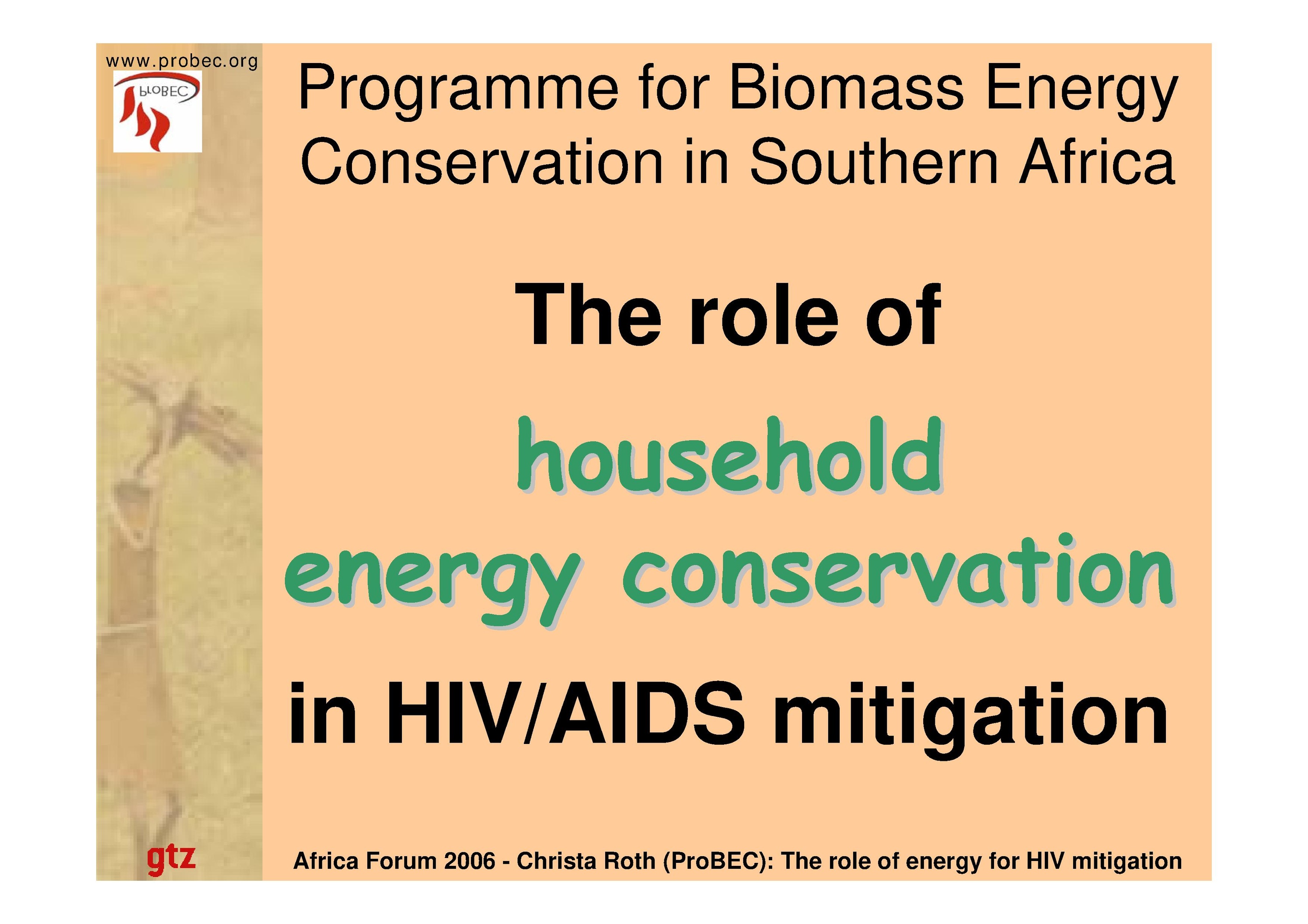
Additional information resources
| References |
Links | |
|---|---|---|
| Roth, Christa: Retained heat cooker: "Fireless cooker" or "Foodwarmer" An illustrated step-by-step description from Malawi showing how to build a food warmer/fireless cooker using a basket, cloth and dried banana leaves. Two recipes for local dishes are included. It is a very helpful document. |
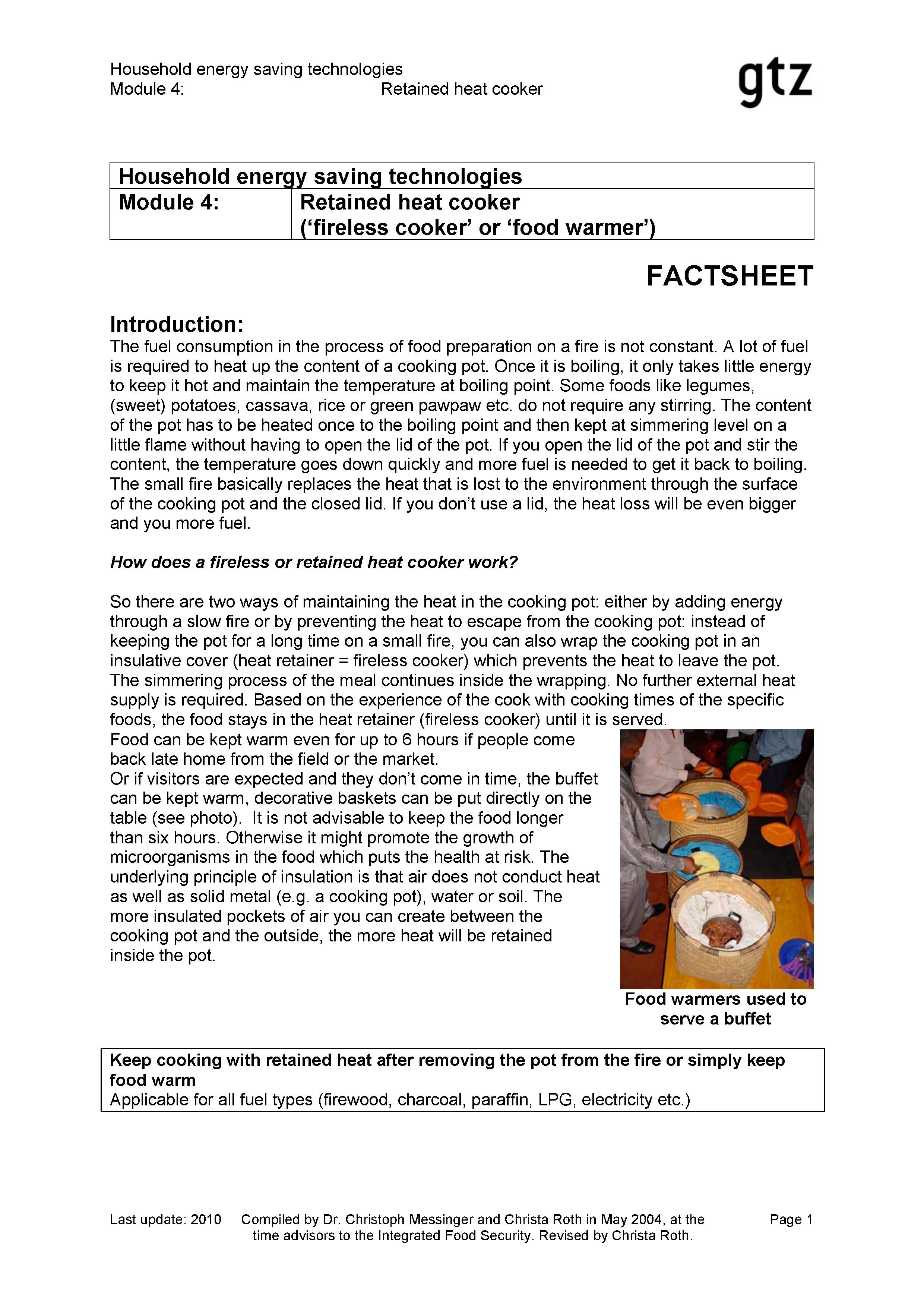
| |
|
Construction manual of a heat retention bag – experience from Tajikistan and Pakistan (English).
|
||
| Experience from Kenya introducing the fireless cookers to women. Vincent Okello, 2009: Engaging communities in alleviating smoke –what the real experts tell you |
http://www.hedon.info/BP57%3AEngagingCommunitiesInAlleviatingSmokeOLD | |
| Retained Heat Cooker Guide written by Don O'Neal | http://www.pciaonline.org/files/RHC%20Guide%20English.pdf | |
| The website provides information on integrated cooking methods. | http://solarcooking.wikia.com/wiki/Integrated_Cooking_Method | |
| The website leads directly to information on heat retention cooking. | http://solarcooking.wikia.com/wiki/Heat-retention_cooking | |
| Information on making a hay box and cooking practices with cooking times, etc. | http://solarcooking.org/heat-retention/ | |
| References to examples on retained heat cooking from Bolivia. | http://www.bioenergylists.org/en/node/245 | |
| References to examples on retained heat cooking from Kenya | http://cookinginabasket.blogspot.com/ | |
| Information on “wonder baskets” introduced in Tanzania. | http://www.sunseedtanzania.org/home.php | |
| Hot bag – Cooking with retained heat and recipes from South Africa http://www.afreca.org |
||
| Marketing material for promoting heat retention bags in Tajikistan through a retailer cooperative (Russian). | 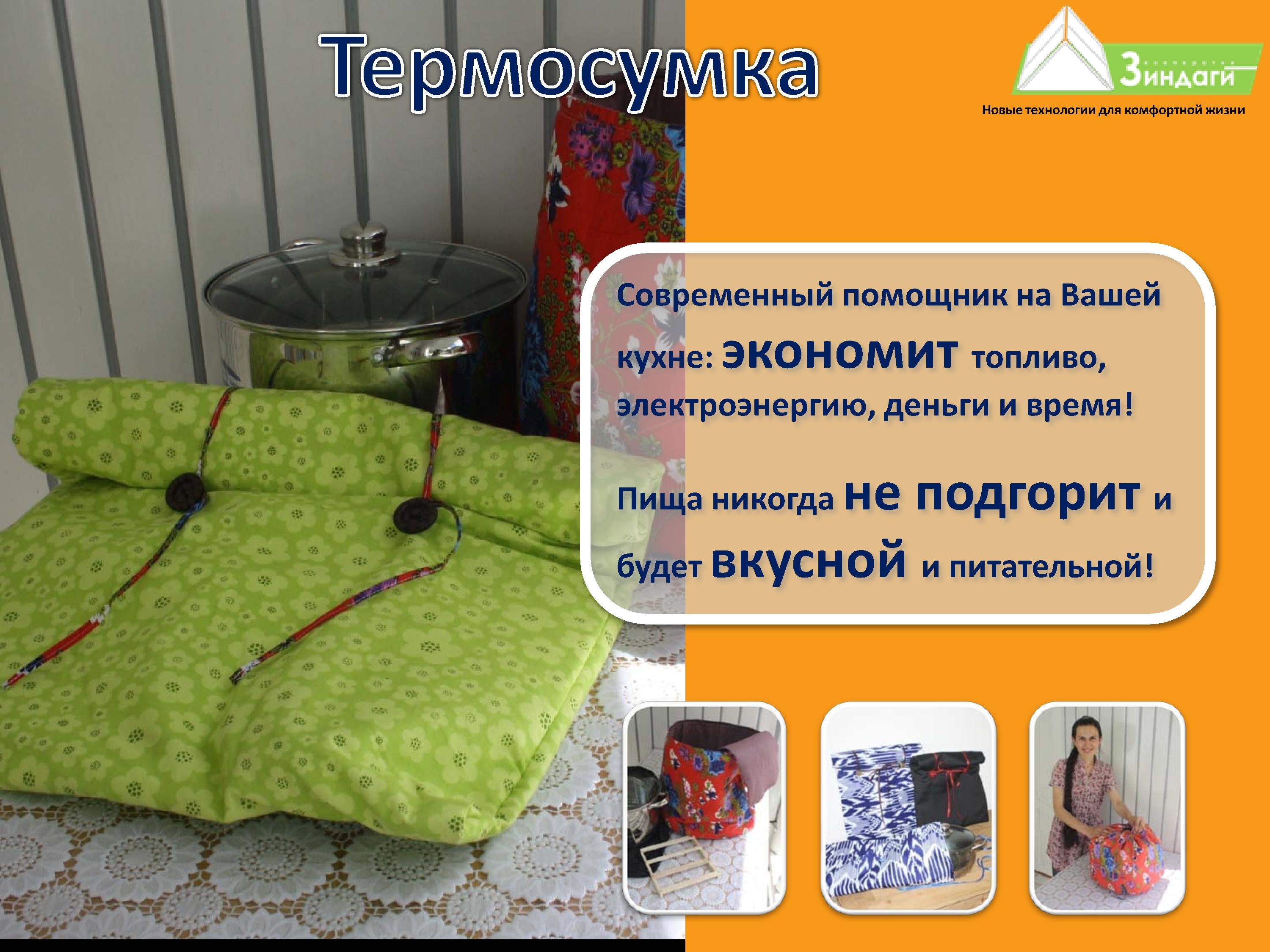 | |
| Cooking book for using the heat retention bag for traditional dishes in Tajikistan (Russian). | 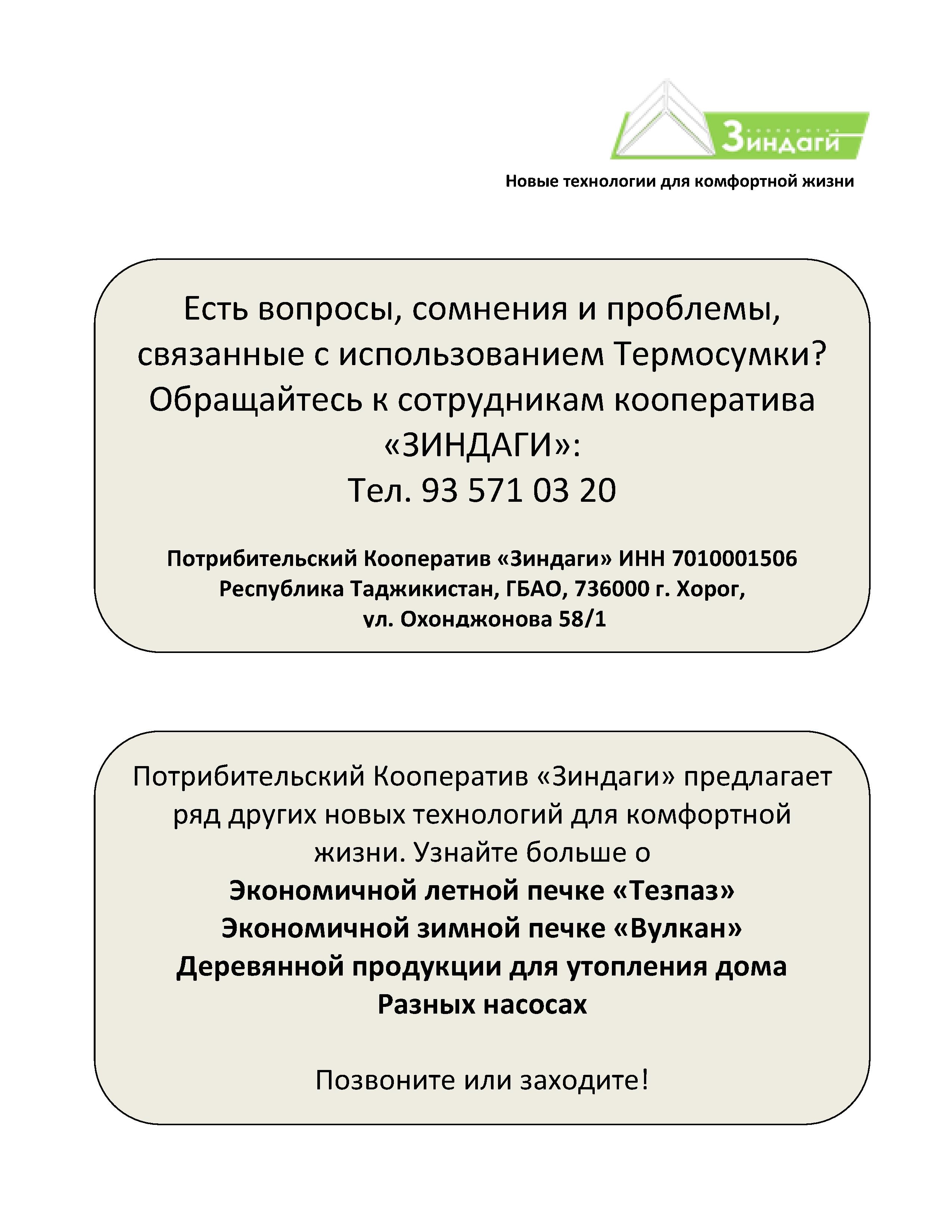 | |
| Heat retention product explanation with guidance on cooking times for special dishes from Tajikistan (Russian) | 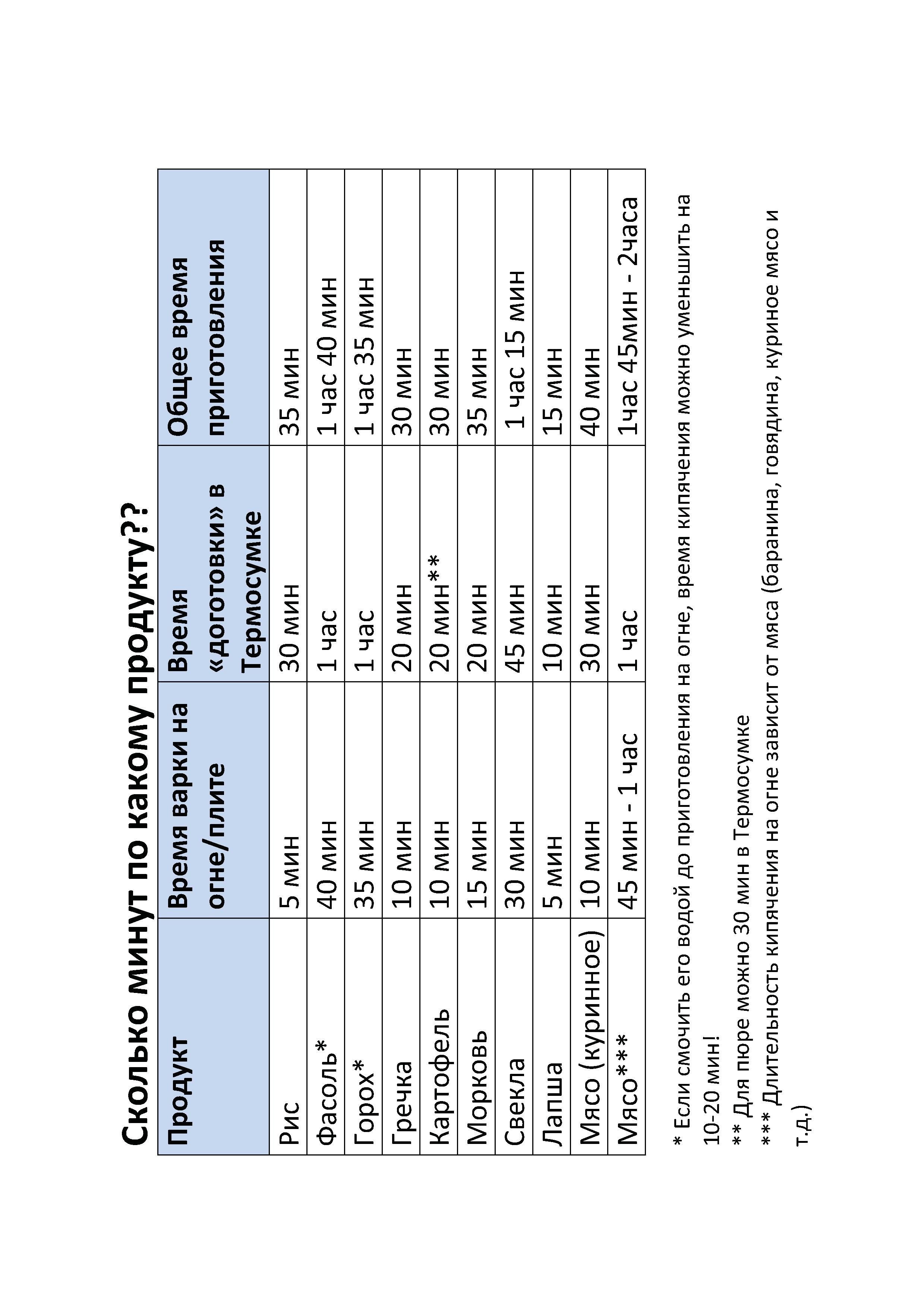 | |
| Commercial website selling heat retention bags. | www.afreca.org/displayproducts.php?zTypeId=ptype121274948383844600 | |
| An example from South Africa shows that with a clever usage metering device, retained heat cookers can qualify to generate carbon credits. | http://www.naturalbalancesa.com/ | |
| Mike Bridgewater: Heat Retention Cooking vs. Solar Cooking The Solar Cooking Archiv |
| |
| Pan Africa Conservation Education: Make a fireless cooker | This step-by step instruction for building a fireless cooker is supplemented with background information on the cooker and its use. It can be downloaded under www.paceproject.net. This homepage provides a number of other helpful documents on resource protection at grassroots level. | |


